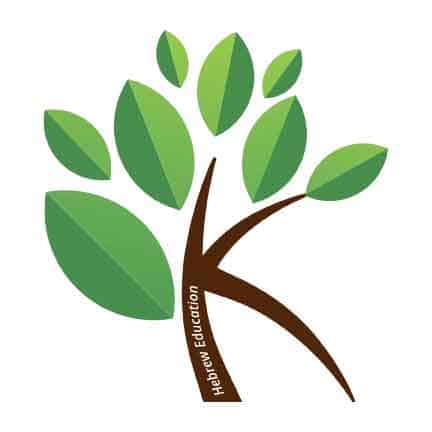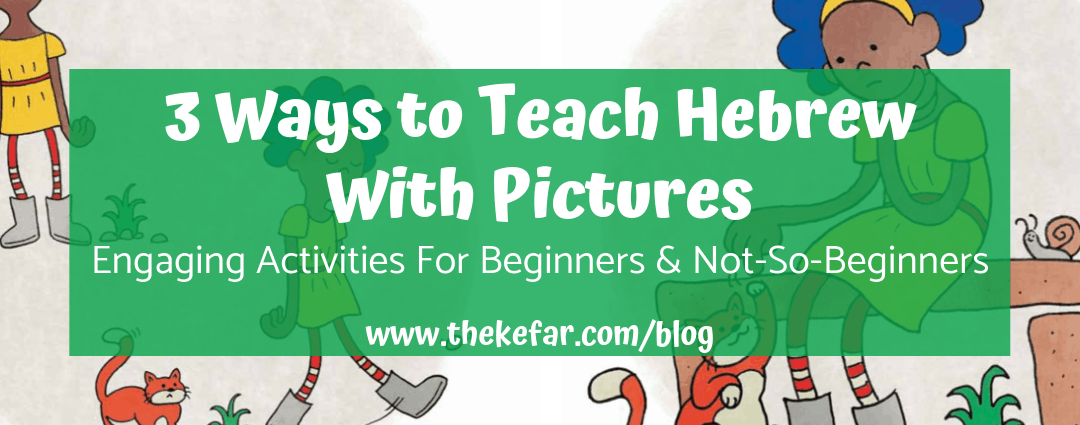I love to teach Hebrew in Hebrew, even to beginners. It’s not as hard as you might think – and that’s not to say it’s easy – but with pictures and drawings, body language and facial expressions, real artifacts and other supports, students can learn Hebrew with minimal use of English.

I’m going to focus on teaching Hebrew with pictures in this post, because it’s one of my favorite teaching tools. They say a picture is worth a thousand words, and this is especially true in the Hebrew language classroom!
Pictures are perfect to use with students who are just starting to learn Hebrew. There aren’t any words, so they don’t need to know how to read, or even the Alef Bet. It provides context to Hebrew vocabulary that students are learning, which leads to actual learning vs. rote memorization. You can also focus on one picture over multiple lessons, each time building off of the previous lesson, so students get the repetition they need in a way that’s not boring.
Here are some of my favorite picture-based activities to help students learn Hebrew:
One Word Images
One Word Image (OWI) is an activity in which students create a short story + image out of a single word, and the teacher guides the process by asking questions. All of this takes place in the target language (so in my case, Hebrew). There’s lots of information on how to do this in a physical classroom full of kids, but almost nothing on OWIs in an online class. So I did what all great teachers do – improvise and adapt!
A One Word Image starts with a word, and almost any word will do, as long as it’s not a proper noun or an animal (and this includes fictional characters like Sponge Bob). In this example below from an actual OWI I did in an online Hebrew lesson with just 2 students, they chose the word anan – cloud. I then asked lots of questions – again, all in Hebrew – to get them to create a story about the anan as though it were a real person with a story that needed telling. Is it big or small? Is it just big or huge? What color is it? Where does it live? How does it feel? Why does it feel that way?
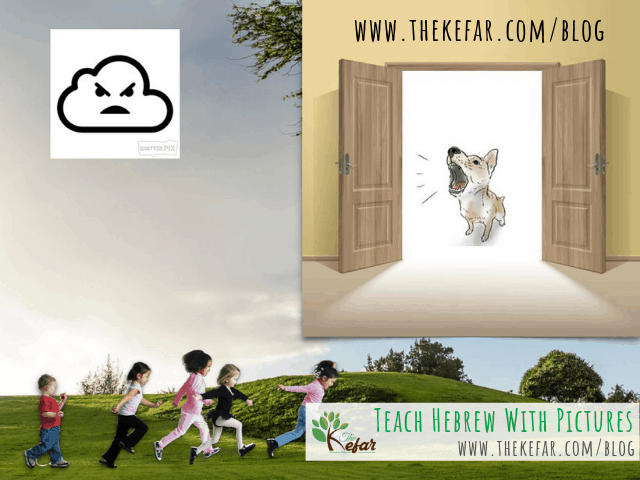
The possibilities for questions are endless, but since I’m guiding the activity as the Hebrew teacher, I can ask the types of questions that my students know how to answer. I give multiple choice options if they have limited vocabulary; I focus on questions that require vocabulary we’ve learned or are learning; and I use body language, facial expressions, and gestures to clarify what I’m asking.
In a traditional One Word Image exercise, one student draws the image as the others are telling the story, but I had only two students. I can’t draw, otherwise I would’ve illustrated the story…but I really can’t draw. So I did the next best thing, which was pull together some clipart photos based on the story they created. As they say, do what you can with what you’ve got!
In the next lesson, I unveiled the picture (students shouldn’t see the image until after they’ve completed the story), and they thought it was the funniest thing ever! We then used the image to review the story – they retold it in their own words, and I asked questions as needed. At the end, they decided they wanted to change the ending, so I added that in…and you can see I wasn’t lying when I said I can’t draw!
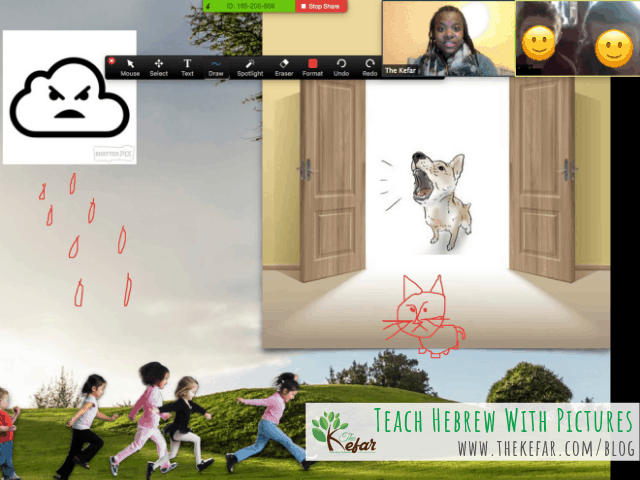
What do YOU think the story was about? Let me know in the comments!
WHAT’S GOING ON?
This activity is simple, and like OWIs, is exactly how it sounds. I show students a picture, and ask them to tell me in Hebrew as much as they can about what’s going on in the picture. There’s no right or wrong way to answer – students can respond with just a list of words, or phrases, or in short sentences, or longer sentences. Sometimes I’ll ask questions, and other times I’ll just listen. I usually begin a student’s first or second Hebrew lesson with the picture below or a similar one. It helps me assess what a student knows in Hebrew, and where their comfort zone lies.
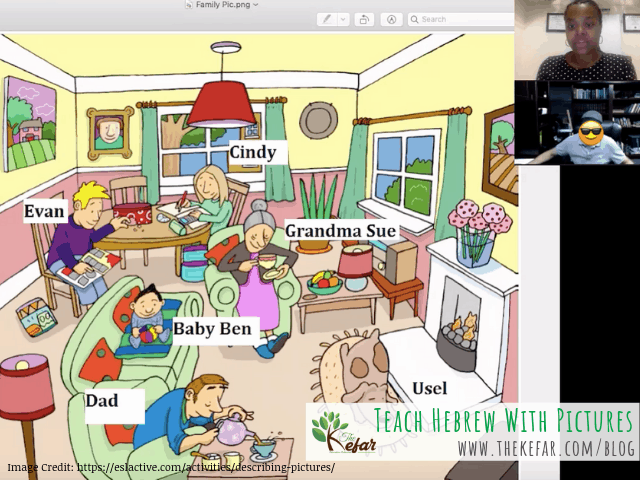
There really is SO much Hebrew content that I can get out of this picture. There are family members + pets (dad, grandma, dog); common verbs (reading, sitting, writing); household objects (table, chair, lamp); prepositions (on, under, near); colors; clothing; numbers. Just like with OWIs, I can ask multiple choice questions, open ended questions, “show me” questions; I can talk about just the pic, I can have them make inferences, we can make comparisons with every day life. I can use this with literally ANY level and make a whole Hebrew lesson out of it – several lessons, even depending on the student!

STORYTELLING
Using a picture to tell a story is an excellent way to help learners developing their Hebrew listening and speaking skills. I can tell a story using a children’s book – with or without words – and use the pictures as a guide. The story can be nice and simple for beginners, and more complex for more advanced learners. Depending on my student’s level, I can:
- Show pictures from a familiar story (3 Little Pigs, Very Hungry Caterpillar) and have them retell it in Hebrew
- Ask them to make a prediction based on a picture before reading a story
- Describe what’s going on in a picture
- Have them create a story using a wordless book (like the one pictured below)
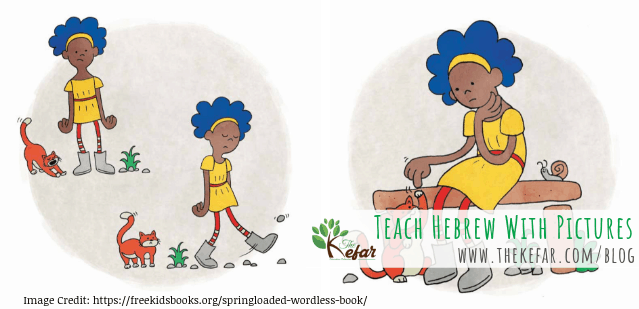
Another picture and story-telling related activity I love to do is to tell a very animated story in Hebrew (complete with my dreadful drawings), and at the end, have students write a paragraph in English summarizing the story. “Why English?” you might be asking, “I thought they were there to learn Hebrew.” Great question.
It’s unrealistic to expect beginner students to be able to retell a story they’re hearing for the first time in Hebrew, even if I ask for 3 sentences. Doing so can be frustrating, demotivating, and demoralizing – none of which we want for our students. Before they can speak Hebrew, they first have to be able to understand Hebrew – you can’t properly communicate in a language you don’t understand. Having them write a summary is one way to show what they can understand. If I see the understanding isn’t there, then it’s my job as a Hebrew teacher to re-present the material in a way that my students can grasp it. If the understanding is there – then I push them to the next level, which is Hebrew speaking.
If you want to experience what it’s like to teach or learn Hebrew with pictures, schedule a Hebrew lesson with me!
